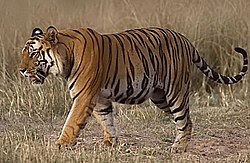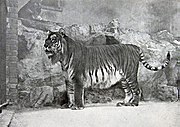Endangered Tiger
| Tiger | ||||||||||||||
|---|---|---|---|---|---|---|---|---|---|---|---|---|---|---|
 A Bengal Tiger (P. tigris tigris) in India's Bandhavgarh National Park.
|
||||||||||||||
| Conservation status | ||||||||||||||
| Scientific classification | ||||||||||||||
|
||||||||||||||
| Binomial name | ||||||||||||||
| Panthera tigris (Linnaeus, 1758) |
||||||||||||||
 Historical distribution of tigers (pale yellow) and 2006 (green).[2]
|
||||||||||||||
| Subspecies | ||||||||||||||
|
P. t. bengalensis |
||||||||||||||
| Synonyms | ||||||||||||||
|
Tigris striatus Severtzov, 1858 |
The tiger (Panthera tigris) is a member of the Felidae family; the largest of the four "big cats" in the genus Panthera.[4] Native to much of eastern and southern Asia, the tiger is an apex predator and an obligate carnivore. Reaching up to 4 metres (13 ft) in total length and weighing up to 300 kilograms (660 pounds), the larger tiger subspecies are comparable in size to the biggest extinct felids.[5][6] Aside from their great bulk and power, their most recognizable feature is the pattern of dark vertical stripes that overlays near-white to reddish-orange fur, with lighter underparts. The most numerous tiger subspecies is the Bengal tiger while the largest subspecies is the Siberian tiger.
Highly adaptable, tigers range from the Siberian taiga, to open grasslands, to tropical mangrove swamps. They are territorial and generally solitary animals, often requiring large contiguous areas of habitat that support their prey demands. This, coupled with the fact that they are endemic to some of the more densely populated places on earth, has caused significant conflicts with humans. Of the nine subspecies of modern tiger, three are extinct and the remaining six are classified as endangered, some critically so. The primary direct causes are habitat destruction and fragmentation, and hunting. Their historical range, which once reached from Mesopotamia and the Caucasus through most of South and East Asia, has been radically reduced. While all surviving species are under formal protection, poaching, habitat destruction and inbreeding depression continue to be threats.
Nonetheless, tigers are among the most recognizable and popular of the world's charismatic megafauna. They have featured prominently in ancient mythology and folklore, and continue to be depicted in modern films and literature. Tigers appear on many flags and coats of arms, as mascots for sporting teams, and as the national animal of several Asian nations.
Naming and etymology
The word "tiger" is taken from the Greek word "tigris", which is possibly derived from a Persian source meaning "arrow", a reference to the animal's speed and also the origin for the name of the River Tigris.[7][8] In American English, "Tigress" was first recorded in 1611. It was one of the many species originally described, as Felis tigris, by Linnaeus in his 18th century work, Systema Naturae.[3][9] The generic component of its scientific designation, Panthera tigris, is often presumed to derive from Greek pan- ("all") and theron ("beast"), but this may be a folk etymology. Although it came into English through the classical languages, panthera is probably of East Asian origin, meaning "the yellowish animal," or "whitish-yellow."[10]
A group of tigers[11] is rare (see below), but when seen together is termed a 'streak' or an 'ambush'.
Range
In the historical past, tigers were widespread in Asia, from the Caucasus and the Caspian Sea, to Siberia and Indonesia. During the 19th century the striped cats completely vanished from western Asia, and became restricted to isolated pockets in the remaining parts of their range. Today, this fragmented relic range extends from India in the west to China and Southeast Asia in the east. The northern limit is close to the Amur River in south eastern Siberia. The only large island inhabited by tigers today is Sumatra. Tigers vanished from Java and Bali during the 20th century, and in Borneo are known only from fossil remains.
Physical characteristics, taxonomy and evolution
The oldest remains of a tiger-like cat, called Panthera palaeosinensis, have been found in China and Java. This species lived about 2 million years ago, at the beginning of the Pleistocene, and was smaller than a modern tiger. The earliest fossils of true tigers are known from Java, and are between 1.6 and 1.8 million years old. Distinct fossils from the early and middle Pleistocene were also discovered in deposits from China, and Sumatra. A subspecies called the Trinil tiger (Panthera tigris trinilensis) lived about 1.2 million years ago and is known fossils found at Trinil in Java.[12]
Tigers first reached India and northern Asia in the late Pleistocene, reaching eastern Beringia (but not the American Continent), Japan, and Sakhalin. Fossils found in Japan indicate that the local tigers were, like the surviving island subspecies, smaller than the mainland forms. This may be due to the phenomenon in which body size is related to environmental space (see insular dwarfism), or perhaps the availability of prey. Until the Holocene, tigers also lived in Borneo, as well as on the island of Palawan in the Philippines.[13]
Physical characteristics
Tigers are perhaps the most recognisable of all the cats (with the possible exception of the lion). They typically have rusty-reddish to brown-rusty coats, a whitish medial and ventral area, a white "fringe" that surrounds the face, and stripes that vary from brown or gray to pure black. The form and density of stripes differs between subspecies (as well as the ground coloration of the fur; for instance, Siberian tigers are usually paler than other tiger subspecies), but most tigers have over 100 stripes. The pattern of stripes is unique to each animal, and thus could potentially be used to identify individuals, much in the same way that fingerprints are used to identify people. This is not, however, a preferred method of identification, due to the difficulty of recording the stripe pattern of a wild tiger. It seems likely that the function of stripes is camouflage, serving to help tigers conceal themselves amongst the dappled shadows and long grass of their environment as they stalk their prey. The stripe pattern is found on a tiger's skin and if shaved, its distinctive camouflage pattern would be preserved. Like other big cats, tigers have a white spot on the backs of their ears.
Tigers have the additional distinction of being the heaviest cats found in the wild.[14] They also have powerfully built legs and shoulders, with the result that they, like lions, have the ability to pull down prey substantially heavier than themselves. However, the subspecies differ markedly in size, tending to increase proportionally with latitude, as predicted by Bergmann's Rule. Thus, large male Siberian Tigers (Panthera tigris altaica) can reach a total length of 3.5 m "over curves" (3.3 m. "between pegs") and a weight of 306 kilograms,[15] which is considerably larger than the sizes reached by island-dwelling tigers such as the Sumatran, the smallest living subspecies with a body weight of only 75-140 kg.[15] Tigresses are smaller than the males in each subspecies, although the size difference between male and female tigers tends to be more pronounced in the larger subspecies of tiger, with males weighing up to 1.7 times as much as the females.[16] In addition, male tigers have wider forepaw pads than females. This difference is often used by biologists in determining the gender of tigers when observing their tracks.[17] The skull of the tiger is very similar to that of the lion, though the frontal region is usually not as depressed or flattened, with a slightly longer postorbital region. The lion's skull has broader nasal openings. However, due to the amount of skull variation in the two species, usually, only the structure of the lower jaw can be used as a reliable indicator of species.[18]
Subspecies
There are eight recent subspecies of tiger, two of which are extinct. Their historical range (severely diminished today) ran through Bangladesh, Siberia, Iran, Afghanistan, India, China, and southeast Asia, including some Indonesian islands. The surviving subspecies, in descending order of wild population, are:
- The Bengal tiger or the Royal Bengal tiger (Panthera tigris tigris) is the most common subspecies of tiger and is found primarily in India and Bangladesh.[19] It lives in varied habitats: grasslands, subtropical and tropical rainforests, scrub forests, wet and dry deciduous forests, and mangroves. Males in the wild usually weigh 205 to 227 kg (450–500 lb), while the average female will weigh about 141 kg.[20] However, the northern Indian and the Nepalese Bengal tigers are somewhat bulkier than those found in the south of the Indian Subcontinent, with males averaging around 235 kilograms (520 lb).[20] While conservationists already believed the population to be below 2,000,[21] the most recent audit by the Indian Government's National Tiger Conservation Authority has estimated the number at just 1,411 wild tigers (1165–1657 allowing for statistical error), a drop of 60% in the past decade.[22] Since 1972, there has been a massive wildlife conservation project, known as Project Tiger, to protect the Bengal tiger. Despite increased efforts by Indian officials, poaching remains rampant and at least one Tiger Reserve (Sariska Tiger Reserve) has lost its entire tiger population to poaching.[23]
- The Indochinese tiger (Panthera tigris corbetti), also called Corbett's tiger, is found in Cambodia, China, Laos, Burma, Thailand, and Vietnam. These tigers are smaller and darker than Bengal tigers: Males weigh from 150–190 kg (330–420 lb) while females are smaller at 110–140 kg (242–308 lb). Their preferred habitat is forests in mountainous or hilly regions. Estimates of the Indochinese tiger population vary between 1,200 to 1,800, with only several hundred left in the wild. All existing populations are at extreme risk from poaching, prey depletion as a result of poaching of primary prey species such as deer and wild pigs, habitat fragmentation and inbreeding. In Vietnam, almost three-quarters of the tigers killed provide stock for Chinese pharmacies.
- The Malayan tiger (Panthera tigris jacksoni), exclusively found in the southern part of the Malay Peninsula, was not considered a subspecies in its own right until 2004. The new classification came about after a study by Luo et al. from the Laboratory of Genomic Diversity Study,[24] part of the National Cancer Institute of the United States. Recent counts showed there are 600–800 tigers in the wild, making it the third largest tiger population, behind the Bengal tiger and the Indochinese tiger. The Malayan tiger is the smallest of the mainland tiger subspecies, and the second smallest living subspecies, with males averaging about 120 kg and females about 100 kg in weight. The Malayan tiger is a national icon in Malaysia, appearing on its coat of arms and in logos of Malaysian institutions, such as Maybank.
- The Sumatran tiger (Panthera tigris sumatrae) is found only on the Indonesian island of Sumatra, and is critically endangered.[25] It is the smallest of all living tiger subspecies, with adult males weighing between 100–140 kg (220–308 lb) and females 75–110 kg (154–242 lb).[26] Their small size is an adaptation to the thick, dense forests of the island of Sumatra where they reside, as well as the smaller-sized prey. The wild population is estimated at between 400 and 500, seen chiefly in the island's national parks. Recent genetic testing has revealed the presence of unique genetic markers, indicating that it may develop into a separate species,[specify] if it does not go extinct.[27] This has led to suggestions that Sumatran tigers should have greater priority for conservation than any other subspecies. While habitat destruction is the main threat to existing tiger population (logging continues even in the supposedly protected national parks), 66 tigers were recorded as being shot and killed between 1998 and 2000, or nearly 20% of the total population.
- The Siberian tiger (Panthera tigris altaica), also known as the Amur, Manchurian, Altaic, Korean or North China tiger, is confined to the Amur-Ussuri region of Primorsky Krai and Khabarovsk Krai in far eastern Siberia, where it is now protected. Considered the largest subspecies, with a head and body length of 190–230 cm (the tail of a tiger is 60–110 cm long) and an average weight of around 227 kilograms (500 lb) for males,[20] the Amur tiger is also noted for its thick coat, distinguished by a paler golden hue and fewer stripes. The heaviest wild Siberian tiger on record weighed in at 384 kg,[28] but according to Mazak these giants are not confirmed via reliable references.[15] Even so, a six-month old Siberian tiger can be as big as a fully grown leopard. The last two censuses (1996 and 2005) found 450–500 Amur tigers within their single, and more or less continuous, range making it one of the largest undivided tiger populations in the world. Genetic research in 2009 demonstrated that the Siberian tiger, and the western "Caspian tiger" (once thought to have been a separate subspecies that became extinct in the wild in the late 1950s[29][30]) are actually the same subspecies, since the separation of the two populations may have occurred as recently as the past century due to human intervention.[31]
- The South China tiger (Panthera tigris amoyensis), also known as the Amoy or Xiamen tiger, is the most critically endangered subspecies of tiger and is listed as one of the 10 most endangered animals in the world.[32][clarification needed] One of the smaller tiger subspecies, the length of the South China tiger ranges from 2.2–2.6 m (87–100 in) for both males and females. Males weigh between 127 and 177 kg (280–390 lb) while females weigh between 100 and 118 kg (220–260 lb). From 1983 to 2007, no South China tigers were sighted.[33] In 2007 a farmer spotted a tiger and handed in photographs to the authorities as proof.[33][34] The photographs in question, however, were later exposed as fake, copied from a Chinese calendar and photoshopped, and the “sighting” turned into a massive scandal.[35][36][37]
In 1977, the Chinese government passed a law banning the killing of wild tigers, but this may have been too late to save the subspecies, since it is possibly already extinct in the wild. There are currently 59 known captive South China tigers, all within China, but these are known to be descended from only six animals. Thus, the genetic diversity required to maintain the subspecies may no longer exist. Currently, there are breeding efforts to reintroduce these tigers to the wild.
Extinct subspecies
- The Balinese tiger (Panthera tigris balica) was limited to the island of Bali. They were the smallest of all tiger subspecies, with a weight of 90–100 kg in males and 65–80 kg in females.[15] These tigers were hunted to extinction—the last Balinese tiger is thought to have been killed at Sumbar Kima, West Bali on 27 September 1937; this was an adult female. No Balinese tiger was ever held in captivity. The tiger still plays an important role in Balinese Hinduism.
- The Javan tiger (Panthera tigris sondaica) was limited to the Indonesian island of Java. It now seems likely that this subspecies became extinct in the 1980s, as a result of hunting and habitat destruction, but the extinction of this subspecies was extremely probable from the 1950s onwards (when it is thought that fewer than 25 tigers remained in the wild). The last confirmed specimen was sighted in 1979, but there were a few reported sightings during the 1990s.[38][39] With a weight of 100-141 kg for males and 75-115 kg for females, the Javan tiger was one of the smaller subspecies, approximately the same size as the Sumatran tiger[citation needed]

Caspian tiger (formerly Panthera Tigris Virgata), also known as the Persian tiger or Turanian tiger was the westernmost population of Siberian tiger, found in Iran, Iraq, Afghanistan, Turkey, Mongolia, Kazakhstan, Caucasus, Tajikistan, Turkmenistan, and Uzbekistan until it apparently became extinct in the late 1950s, though there have been several alleged sightings of the tiger.[30] Though originally thought to have been a distinct subspecies, genetic research in 2009 suggest that the animal was largely identical to the Siberian tiger.[31]
Hybrids
Hybridization among the big cats, including the tiger, was first conceptualized in the 19th century, when zoos were particularly interested in the pursuit of finding oddities to display for financial gain.[40] Lions have been known to breed with tigers (most often the Amur and Bengal subspecies) to create hybrids called ligers and tigons.[41] Such hybrids were once commonly bred in zoos, but this is now discouraged due to the emphasis on conserving species and subspecies. Hybrids are still bred in private menageries and in zoos in China.
The liger is a cross between a male lion and a tigress.[42] Because the lion sire passes on a growth-promoting gene, but the corresponding growth-inhibiting gene from the female tiger is absent, ligers grow far larger than either parent. They share physical and behavioural qualities of both parent species (spots and stripes on a sandy background). Male ligers are sterile, but female ligers are often fertile. Males have about a 50% chance of having a mane, but, even if they do, their manes will be only around half the size of that of a pure lion. Ligers are typically between 10 to 12 feet in length, and can be between 800 and 1,000 pounds or more.[42]
The less common tigon is a cross between the lioness and the male tiger.[43]
Colour variations
White tigers

There is a well-known mutation that produces the white tiger, technically known as chinchilla albinistic,[44] an animal which is rare in the wild, but widely bred in zoos due to its popularity. Breeding of white tigers will often lead to inbreeding (as the trait is recessive). Many initiatives have taken place in white and orange tiger mating in an attempt to remedy the issue, often mixing subspecies in the process. Such inbreeding has led to white tigers having a greater likelihood of being born with physical defects, such as cleft palates and scoliosis (curvature of the spine).[45][46] Furthermore, white tigers are prone to having crossed eyes (a condition known as strabismus). Even apparently healthy white tigers generally do not live as long as their orange counterparts. Recordings of white tigers were first made in the early 19th century.[47] They can only occur when both parents carry the rare gene found in white tigers; this gene has been calculated to occur in only one in every 10,000 births. The white tiger is not a separate sub-species, but only a colour variation; since the only white tigers that have been observed in the wild have been Bengal tigers[48] (and all white tigers in captivity are at least part Bengal), it is commonly thought that the recessive gene that causes the white colouring is probably carried only by Bengal tigers, although the reasons for this are not known.[45][49] Nor are they in any way more endangered than tigers are generally, this being a common misconception. Another misconception is that white tigers are albinos, despite the fact that pigment is evident in the white tiger's stripes. They are distinct not only because of their white hue; they also have blue eyes and pink noses.
Golden tabby tigers

In addition, another recessive gene may create a very unusual "golden tabby" colour variation, sometimes known as "strawberry." Golden tabby tigers have light gold fur, pale legs and faint orange stripes. Their fur tends to be much thicker than normal.[50] There are extremely few golden tabby tigers in captivity, around 30 in all. Like white tigers, strawberry tigers are invariably at least part Bengal. Some golden tabby tigers, called heterozygous tigers, carry the white tiger gene, and when two such tigers are mated, can produce some stripeless white offspring. Both white and golden tabby tigers tend to be larger than average Bengal tigers.
Other colour variations
There are also unconfirmed reports of a "blue" or slate-coloured tiger, the Maltese Tiger, and largely or totally black tigers, and these are assumed, if real, to be intermittent mutations rather than distinct species.[44]
Biology and behaviour
Territorial behavior
Tigers are essentially solitary and territorial animals. The size of a tiger's home range mainly depends on prey abundance, and, in the case of male tigers, on access to females. A tigress may have a territory of 20 square kilometres while the territories of males are much larger, covering 60–100 km2. The ranges of males tend to overlap those of several females.
The relationships between individuals can be quite complex, and it appears that there is no set "rule" that tigers follow with regards to territorial rights and infringing territories. For instance, although for the most part tigers avoid each other, both male and female tigers have been documented sharing kills. For instance, George Schaller observed a male tiger share a kill with two females and four cubs. Females are often reluctant to let males near their cubs, but Schaller saw that these females made no effort to protect or keep their cubs from the male, suggesting that the male might have been the father of the cubs. In contrast to male lions, male tigers will allow the females and cubs to feed on the kill first. Furthermore, tigers seem to behave relatively amicably when sharing kills, in contrast to lions, which tend to squabble and fight. Unrelated tigers have also been observed feeding on prey together. The following quotation is from Stephen Mills' book Tiger, as he describes an event witnessed by Valmik Thapar and Fateh Singh Rathore in Ranthambhore:[51]
A dom











